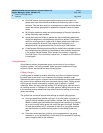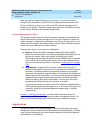
MERLIN LEGEND Communications System Release 5.0
System Manager’s Guide
555-650-118
Issue 1
June 1997
Features and Applications
Page 4-50Features
4
■ The light on a Calls-In-Queue Alarm button on a phone goes on when too
many calls are waiting for the group. In Release 5.0 and later systems, the
system manager or calling group supervisor can specify up to three alarm
levels to indicate increasing severity.
■ A delay announcement device can be programmed to play a recording that
describes a delay to waiting callers. In Release 5.0 and later systems, a
secondary device and message can be set up for each group, allowing
callers to hear a primary message first, then a secondary message that
may repeat. In addition, as many as 10 primary delay announcement
devices can serve waiting callers in Release 5.0 and later systems. (Music
On Hold can also entertain people who are waiting for a group member’s
attention.)
NOTE:
When you change a delay announcement, you may need to adjust
the delay announcement interval to ensure that callers do not wait to
long for the announcement and that Music On Hold or special
ringback does not interrupt the announcement. See the
Feature
Reference
for details.
■ Other extensions or an operator can provide coverage when all the group
members are unavailable and too many callers are waiting.
■ An extension can be assigned to receive messages for a calling group.
Calling groups can be used to designate extensions used by voice messaging
systems or fax machines, so that these devices can receive calls directed to a
single extension number.
NOTE:
The
Feature Reference
provides detailed information designed to help
calling group supervisors and system managers plan calling group options.
Night Service Groups 4
Night Service groups are assigned for the purpose of Night Service operation,
which changes coverage, and potentially calling restrictions, outside of normal
business hours. The system manager assigns extensions (including one calling
group if desired) and lines (Release 4.1 and later systems only) to a Night Service
group, which in turn is assigned to a system operator with a programmed Night
Service button on his or her extension. When the operator uses the button to turn
Night Service on, calls ring immediately at the extensions in the group. When it is
time for normal operation to resume, the operator turns Night Service off.
Beginning with Release 4.1, lines that should ring immediately must also be
assigned to a Night Service group. These lines need not be assigned to the
operator for the group (particularly useful for personal lines), and their Night
Service status is not affected by Night Service operation at the extension of an
operator who handles another Night Service group. If a line is assigned to an


















